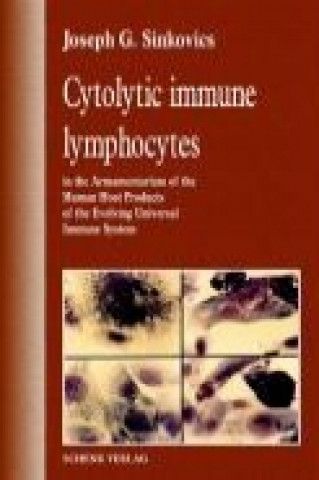
Kód: 12809148
Cytolytic immune lymphocytes
Autor Joseph G. Sinkovics
The Monograph: "Cytotoxic Lymphocytes of the Human Host. Products of the Evolving Universal Immune System." Joseph G. Sinkovics. St. Joseph's Hospital Cancer Institute Affiliated with the H.L. Moffitt Comprehensive Cancer Cente ... celý popis
- Jazyk:
 Angličtina
Angličtina - Vazba: Pevná
- ISBN-13: 9783939337577
Nakladatelství: Schenk Verlag GmbH, 2008
- Více informací o knize

Mohlo by se vám také líbit
-

Der Kava-Markt in Fidschi
1744 Kč -

Seljacka Buna: Povijesni Roman
351 Kč
Informovat o naskladnění knihy
Zadejte do formuláře e-mailovou adresu a jakmile knihu naskladníme, zašleme vám o tom zprávu. Pohlídáme vše za vás.
Více informací o knize Cytolytic immune lymphocytes
 Anotace knihy
Anotace knihy
The Monograph: "Cytotoxic Lymphocytes of the Human Host. Products of the Evolving Universal Immune System." Joseph G. Sinkovics. St. Joseph's Hospital Cancer Institute Affiliated with the H.L. Moffitt Comprehensive Cancer Center at the University of South Florida; Departments of Medical Microbiology & Immunology, and Molecular Medicine, University of South Florida College of Medicine, Tampa, FL, USA.The German-Hungarian Publisher SchenkVerlag Campus Dialog (Pécs, Hungary; Passau, Germany: [email protected]) publishes this monograph. This presentation is an illustrated account of the monograph's contents. Part I is devoted to molecular cell biology re-capitulating the formation of the first cells, their vertical and horizontal acquisition of new genes, using for examples extant archaea and primitive prokaryotes. A bold proposal is elaborated on the formation of the first eukaryotic nucleated cells from ancient virally mediated fusions of archaeal and prokaryotic spheroplasts. A detailed account on the evolution of viruses follows. The well preserved innate immune faculties (TLRs, chemokines, cytokines, complement, opsonins and bactericidal substances) include a detailed description of the interferons, and interfering iRNAs. The first multicellular organisms in the Cambrian sea already possessed dendritic cells and natural killer (NK) cells. Part II traces back the origin of the RAG, RSS and V(D)J genomic sequences to ancient retrotransposons entering the genomes of ancient sharks. Another original proposal is that an ancestral herpesvirus transduced the RAG genes from sea urchins to sharks; the extant EBV still operates RAG-like genomic sequences. The entire adaptive immune system consisting of NKT, CD4 and CD8 T cells and antibody-secreting plasma cells becomes functional at this level. On one side, there is a fine-tuned cooperation between the innate and adaptive immune systems. On the other side, the mammalian placenta compromised the united innate and adaptive immune system by forcing it to accept the semi-allogeneic fetus. In terms of molecular immunobiology, both the placenta (temporarily), and the malignant tumor (permanently) utilize the same mechanisms of immunosuppression in order to achieve acceptance and nurturing by the host. Part III is devoted to human tumor immunology/immunotherapy (vaccines; adoptive immune lymphocyte therapy and monoclonal antibodies). In an extraordinary chapter, the author describes the formation of a natural hybridoma between an antibody-secreting plasma cell and a lymphoma cell in the mouse; the description of this well documented and understood natural hybridoma predated by 5 years the Nobel-Prize winning discovery of Köhler & Milstein. Now the author proposes that the Sézary cell is a natural T cell hybridoma formed by the malignant mycosis fungoides T cell and a regulatory T cell. Part IV is devoted to molecular immunobiology of human autoimmune diseases. The reactivation of HER occurring during somatic hypermutations of lymphoid cells receives great attention, as budding HER particles appear in lymphoid cell involved both in lymphomagenesis and autoimmunity. Part V compares the generation of Th1- and Th2-type immune reactions of the host to exogenous pathogens (viruses, bacteria, fungi, parasites and worms) and to endogenous tumor cells. The comparison yields fascinating results. Part VI is a Concise Synopsis summarizing the most recent data from 2007-8 of molecular cell biology and immunology, epigenetic tumor cell biology, the newest results with tumor vaccines, oncolytic viruses, and adoptive therapy with immune lymphocytes. There are 16 summary Tables and 12 large illustrations (figures, plates and graphs); and the number of selected and explained up-to-date references reaches 2370.TLR = Toll-like receptors RAG = recombination activating genes RSS = recombination signal sequencesV(D)J = variable, diversity, joining EBV = Epstein-Barr virus HER =human endogenous retroviruses
 Parametry knihy
Parametry knihy
- Plný název: Cytolytic immune lymphocytes
- Autor: Joseph G. Sinkovics
- Jazyk:
 Angličtina
Angličtina - Vazba: Pevná
- EAN: 9783939337577
- ISBN: 3939337579
- ID: 12809148
- Nakladatelství: Schenk Verlag GmbH
- Hmotnost: 1489 g
- Rozměry: 275 × 211 × 29 mm
- Datum vydání: August 2008
Oblíbené z jiného soudku
-

Dune
249 Kč -

Haunting Adeline
621 Kč -

Berserk Deluxe Volume 2
1092 Kč -

White Nights
71 Kč -

Powerless
268 Kč -

Atomic Habits
330 Kč -

Dune Messiah
228 Kč -

Berserk Deluxe Volume 3
1142 Kč -

One Day
221 Kč -

Berserk Deluxe Volume 1
1115 Kč -

Iron Flame
368 Kč -

Surrounded by Idiots
213 Kč -

Harry Potter and the Prisoner of Azkaban (Minalima Edition)
993 Kč -

Gravity Falls Journal 3
441 Kč -

Heaven Official's Blessing: Tian Guan Ci Fu (Novel) Vol. 1
430 Kč -

The Creative Act
568 Kč -

Dune
276 Kč -

Hunting Adeline
624 Kč -

A Little Life
268 Kč -

Children of Dune
230 Kč -

Heaven Official's Blessing: Tian Guan Ci Fu (Novel) Vol. 2
427 Kč -

Bungo Stray Dogs, Vol. 8 (light novel)
382 Kč -

Percy Jackson and the Olympians 5 Book Paperback Boxed Set
944 Kč -

Solo Leveling, Vol. 1
440 Kč -

The Prisoner's Throne
247 Kč -

Court of Thorns and Roses
206 Kč -

Cry Baby Coloring Book
276 Kč -

Fourth Wing
444 Kč -

Icebreaker
205 Kč -

Berserk Deluxe Volume 6
1089 Kč -

Avatar, the Last Airbender: The Kyoshi Novels (Box Set)
968 Kč -

The 48 Laws of Power
608 Kč -

House of Leaves
611 Kč -

Twisted Lies
213 Kč -

Dune Messiah
277 Kč -

No Longer Human
311 Kč -

48 Laws Of Power
331 Kč -

Twisted Games
213 Kč -

Caraval Paperback Boxed Set
902 Kč -

Solo Leveling, Vol. 2
437 Kč -

Open Circuits
907 Kč -

Berserk Deluxe Volume 5
1119 Kč -

Heaven Official's Blessing: Tian Guan Ci Fu (Novel) Vol. 3
429 Kč -

Berserk Deluxe Volume 4
1125 Kč -

Court of Mist and Fury
206 Kč -

SOLO LEVELING V08
436 Kč -

English File Upper Intermediate Multipack A (4th)
487 Kč -

CHAINSAW MAN V14
254 Kč -

Before the Coffee Gets Cold
198 Kč
Osobní odběr Praha, Brno a 12903 dalších
Copyright ©2008-24 nejlevnejsi-knihy.cz Všechna práva vyhrazenaSoukromíCookies



 Vrácení do měsíce
Vrácení do měsíce 571 999 099 (8-15.30h)
571 999 099 (8-15.30h)